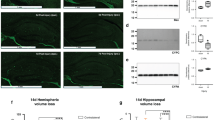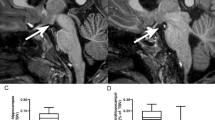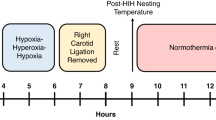Abstract
Background
Therapeutic hypothermia (TH) is the standard of care for neonates with hypoxic–ischemic encephalopathy, but it is not fully protective in the clinical setting. Hypoxia–ischemia (HI) may cause white matter injury (WMI), leading to neurological and cognitive dysfunction.
Methods
P9 mice were subjected to HI as previously described. Pups underwent 3.5 h of systemic hypothermia or normothermia. Cresyl violet and Perl’s iron staining for histopathological scoring of brain sections was completed blindly on all brains. Immunocytochemical (ICC) staining for myelin basic protein (MBP), microglia (Iba1), and astrocytes (glia fibrillary acidic protein (GFAP)) was performed on adjacent sections. Volumetric measurements of MBP coverage were used for quantitative analysis of white matter.
Results
TH provided neuroprotection by injury scoring for the entire group (n=44; P<0.0002). ICC analysis of a subset of brains showed that the lateral caudate was protected from WMI (P<0.05). Analysis revealed decreased GFAP and Iba1 staining in hippocampal regions, mostly CA2/CA3. GFAP and Iba1 directly correlated with injury scores of normothermic brains.
Conclusion
TH reduced injury, and qualitative data suggest that hippocampus and lateral caudate are protected from HI. Mildly injured brains may better show the benefits of TH. Overall, these data indicate regional differences in WMI susceptibility and inflammation in a P9 murine HI model.
Similar content being viewed by others
Log in or create a free account to read this content
Gain free access to this article, as well as selected content from this journal and more on nature.com
or
References
Jacobs SE, Berg M, Hunt R, Tarnow-Mordi WO, Inder TE, Davis PG . Cooling for newborns with hypoxic ischaemic encephalopathy. Cochrane Database Syst Rev 2013;1:CD003311.
Gonzalez FF, Ferriero DM . Therapeutics for neonatal brain injury. Pharmacol Ther 2008;120:43–53.
Azzopardi DV, Strohm B, Edwards AD et al, Moderate hypothermia to treat perinatal asphyxial encephalopathy. N Engl J Med 2009;361:1349–58.
Gluckman PD, Wyatt JS, Azzopardi D et al, Selective head cooling with mild systemic hypothermia after neonatal encephalopathy: multicenter randomised trial. Lancet 2005;365:663–70.
Shankaran S, Laptook AR, Ehrenkranz RA et al, Whole-body hypothermia for neonates with hypoxic-ischemic encephalopathy. N Engl J Med 2005;353:1574–84.
Drury PP, Gunn ER, Bennet L, Gunn AJ . Mechanisms of hypothermic neuroprotection. Clin Perinatol 2014;41:161–75.
Fang AY, Gonzalez FF, Sheldon RA, Ferriero DM . Effects of combination therapy using hypothermia and erythropoietin in a rat model of neonatal hypoxia–ischemia. Pediatr Res 2013;73:12–7.
Carlsson Y, Wang X, Schwendimann L et al, Combined effect of hypothermia and caspase-2 gene deficiency on neonatal hypoxic-ischemic brain injury. Pediatr Res 2012;71:566–72.
Sabir H, Scull-Brown E, Liu X, Thoresen M . Immediate Hypothermia Is Not Neuroprotective After Severe Hypoxia-Ischemia and Is Deleterious When Delayed by 12 Hours in Neonatal Rats. Stroke 2012;43:3364–3370.
Williams CE, Gunn AJ, Mallard C, Gluckman PD . Outcome after ischemia in the developing sheep brain: An electroencephalographic and histological study. Ann Neurol 1992;31:14–21.
Liu Y, Silverstein FS, Skoff R, Barks JDE . Hypoxic-ischemic oligodendroglial injury in neonatal rat brain. Pediatr Res 2002;51:25–33.
Nave K-A, Werner HB . Myelination of the nervous system: mechanisms and functions. Ann Rev Cell Dev Biol 2014;30:503–33.
McQuillen PS, Ferriero DM . Selective vulnerability in the developing central nervous system. Pediatr Neurol 2004;30:227–35.
Back SA, Gan X, Li Y, Rosenberg PA, Volpe JJ . Maturation-dependent vulnerability of oligodendrocytes to oxidative stress-induced death caused by glutathione depletion. J Neurosci 1998;18:6241–53.
Juliano C, Sosunov S, Niatsetskaya Z et al, Mild intermittent hypoxemia in neonatal mice causes permanent neurofunctional deficit and white matter hypomyelination. Exp Neurol 2015;264:33–42.
Back SA, Riddle A, McClure MM . Maturation-dependent vulnerability of perinatal white matter in premature birth. Stroke 2007;38:724–30.
Burnsed JC, Chavez-Valdez R, Hossain MS et al, Hypoxia-ischemia and therapeutic hypothermia in the neonatal mouse brain – a longitudinal study. PLoS ONE 2015;10:e0118889.
Roelfsema V, Bennet L, George S et al, Window of opportunity of cerebral hypothermia for postischemic white matter injury in the near-term fetal sheep. J Cereb Blood Flow Metab 2004;24:877–886.
Rice JE, Vannucci RC, Brierley JB . The influence of immaturity on hypoxic-ischemic brain damage in the rat. Ann Neurol 1981;9:131–41.
Sheldon RA, Sedik C, Ferriero DM . Strain-related brain injury in neonatal mice subjected to hypoxia–ischemia. Brain Res 1998;810:114–22.
Sheldon RA, Hall JJ, Noble LJ, Ferriero DM . Delayed cell death in neonatal mouse hippocampus from hypoxia-ischemia is neither apoptotic nor necrotic. Neurosci Lett 2001;304:165–8.
Chevin M, Guiraut C, Maurice-Gelinas C, Deslauriers J, Grignon S, Sébire G . Neuroprotective effects of hypothermia in inflammatory-sensitized hypoxic-ischemic encephalopathy. Int J Dev Neurosci 2016;55:1–8.
Graf AE, Haines KM, Pierson CR et al, Perinatal inflammation results in decreased oligodendrocyte numbers in adulthood. Life Sci 2014;94:164–71.
Ek CJ, D’Angelo B, Lehner C, Nathanielsz P, Li C, Mallard C . Expression of tight junction proteins and transporters for xenobiotic metabolism at the blood–CSF barrier during development in the nonhuman primate (P. hamadryas. Reprod Toxicol 2015;56:32–44.
Zhu C, Wang X, Cheng X et al, Post-ischemic hypothermia-induced tissue protection and diminished apoptosis after neonatal cerebral hypoxia–ischemia. Brain Res 2004;996:67–75.
Wagner BP, Nedelcu J, Martin E . Delayed postischemic hypothermia improves long-term behavioral outcome after cerebral hypoxia-ischemia in neonatal rats. Pediatr Res 2002;51:354–60.
Mishima K, Ikeda T, Yoshikawa T et al, Effects of hypothermia and hyperthermia on attentional and spatial learning deficits following neonatal hypoxia-ischemic insult in rats. Behav Brain Res 2004;151:209–17.
Liu Y, Barks JD, Xu G, Silverstein FS . Topiramate extends the therapeutic window for hypothermia-mediated neuroprotection after stroke in neonatal rats. Stroke 2004;35:1460–5.
Barks JD, Liu Y-Q, Shangguan Y, Silverstein FS . Phenobarbital augments hypothermic neuroprotection. Pediatr Res 2010;67:532–7.
Liu Y, Shangguan Y, Barks JDE, Silverstein FS . Bumetanide augments the neuroprotective efficacy of phenobarbital plus hypothermia in a neonatal hypoxia-ischemia model. Pediatr Res 2012;71:559–65.
Gunn AJ, Bennet L, Gunning MI, Gluckman PD, Gunn TR . Cerebral hypothermia is not neuroprotective when started after postischemic seizures in fetal sheep. Pediatr Res 1999;46:274–80.
Davidson JO, Yuill CA, Zhang FG, Wassink G, Bennet L, Gunn AJ . Extending the duration of hypothermia does not further improve white matter protection after ischemia in term-equivalent fetal sheep. Sci Rep 2016;6:25178.
Kattwinkel J, Perlman JM, Aziz K et al, Neonatal resuscitation: 2010 American Heart Association Guidelines for Cardiopulmonary Resuscitation and Emergency Cardiovascular Care. Pediatrics 2010;126:e1400–13.
Perlman JM, Wyllie J, Kattwinkel J et al, Part 11: neonatal resuscitation: 2010 International Consensus on Cardiopulmonary Resuscitation and Emergency Cardiovascular Care Science With Treatment Recommendations. Circulation 2010;122:S516–38.
Rutherford M, Ramenghi LA, Edwards AD et al, Assessment of brain tissue injury after moderate hypothermia in neonates with hypoxic–ischaemic encephalopathy: a nested substudy of a randomised controlled trial. Lancet Neurol 2010;9:39–45.
Shankaran S, Barnes PD, Hintz SR et al, Brain injury following trial of hypothermia for neonatal hypoxic–ischaemic encephalopathy. Arch Dis Child Fetal Neonatal Ed 2012;97:F398–404.
Nathan C . Points of control in inflammation. Nature 2002;420:846–52.
Middeldorp J, Hol EM . GFAP in health and disease. Prog Neurobiol 2011;93:421–43.
McRae A, Gilland E, Bona E, Hagberg H . Microglia activation after neonatal hypoxic-ischemia. Brain Res Dev Brain Res 1995;84:245–52.
Saliba E, Henrot A . Inflammatory mediators and neonatal brain damage. Neonatology 2001;79:224–7.
Hagberg H, Mallard C, Ferriero DM et al, The role of inflammation in perinatal brain injury. Nat Rev Neurol 2015;11:192–208.
Fernández-López D, Faustino J, Klibanov AL et al, Microglial cells prevent hemorrhage in neonatal focal arterial stroke. J Neurosci 2016;36:2881–93.
Chip S, Fernández-López D, Li F, Faustino J, Derugin N, Vexler ZS . Genetic deletion of galectin-3 enhances neuroinflammation, affects microglial activation and contributes to sub-chronic injury in experimental neonatal focal stroke. Brain Behav Immun 2016;60:270–81.
Robertson NJ, Faulkner S, Fleiss B et al, Melatonin augments hypothermic neuroprotection in a perinatal asphyxia model. Brain 2013;136:90–105.
Acknowledgements
EK was sponsored by the American Pediatric Society & Society for Pediatric Research Summer Medical Student Program. This work was supported by NS 33997. DMF was supported by National Institutes of Health 33997.
Author information
Authors and Affiliations
Corresponding author
Ethics declarations
Competing interests
The authors declare no conflict of interest.
Additional information
Supplementary material is linked to the online version of the paper at
Rights and permissions
About this article
Cite this article
Koo, E., Sheldon, R., Lee, B. et al. Effects of therapeutic hypothermia on white matter injury from murine neonatal hypoxia–ischemia. Pediatr Res 82, 518–526 (2017). https://doi.org/10.1038/pr.2017.75
Received:
Accepted:
Published:
Issue date:
DOI: https://doi.org/10.1038/pr.2017.75
This article is cited by
-
Neuroprotective effect of the combination therapy of melatonin and URB447 after neonatal hypoxia-ischemia
BMC Complementary Medicine and Therapies (2025)
-
The role of ApoE in fatty acid transport from neurons to astrocytes under ischemia/hypoxia conditions
Molecular Biology Reports (2024)
-
Safety and efficacy of therapeutic hypothermia in neonates with mild hypoxic-ischemic encephalopathy
BMC Pediatrics (2023)
-
Exosomes derived from astrocytes after oxygen-glucose deprivation promote differentiation and migration of oligodendrocyte precursor cells in vitro
Molecular Biology Reports (2021)
-
Sevoflurane Post-Conditioning Ameliorates Neuronal Deficits and Axon Demyelination After Neonatal Hypoxic Ischemic Brain Injury: Role of Microglia/Macrophage
Cellular and Molecular Neurobiology (2021)



